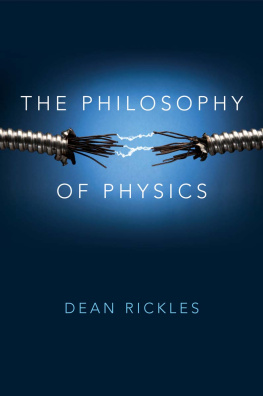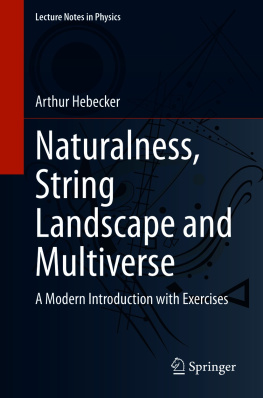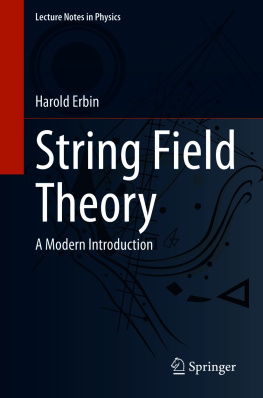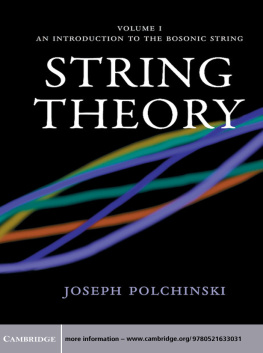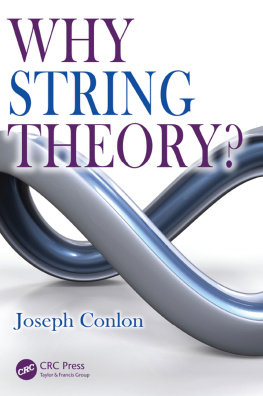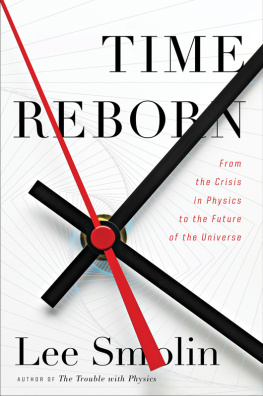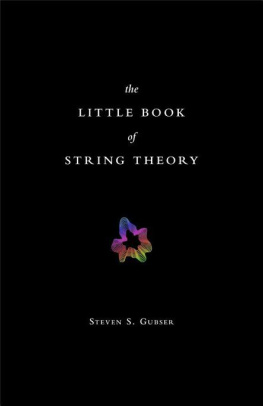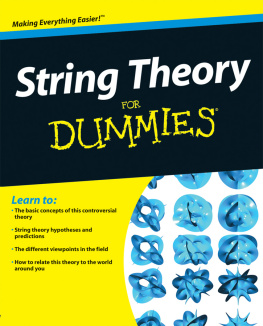Rickles - A Brief History of String Theory From Dual Models to M-Theory
Here you can read online Rickles - A Brief History of String Theory From Dual Models to M-Theory full text of the book (entire story) in english for free. Download pdf and epub, get meaning, cover and reviews about this ebook. City: Berlin;Heidelberg, year: 2016, publisher: Springer, genre: Children. Description of the work, (preface) as well as reviews are available. Best literature library LitArk.com created for fans of good reading and offers a wide selection of genres:
Romance novel
Science fiction
Adventure
Detective
Science
History
Home and family
Prose
Art
Politics
Computer
Non-fiction
Religion
Business
Children
Humor
Choose a favorite category and find really read worthwhile books. Enjoy immersion in the world of imagination, feel the emotions of the characters or learn something new for yourself, make an fascinating discovery.
A Brief History of String Theory From Dual Models to M-Theory: summary, description and annotation
We offer to read an annotation, description, summary or preface (depends on what the author of the book "A Brief History of String Theory From Dual Models to M-Theory" wrote himself). If you haven't found the necessary information about the book — write in the comments, we will try to find it.
Rickles: author's other books
Who wrote A Brief History of String Theory From Dual Models to M-Theory? Find out the surname, the name of the author of the book and a list of all author's works by series.
A Brief History of String Theory From Dual Models to M-Theory — read online for free the complete book (whole text) full work
Below is the text of the book, divided by pages. System saving the place of the last page read, allows you to conveniently read the book "A Brief History of String Theory From Dual Models to M-Theory" online for free, without having to search again every time where you left off. Put a bookmark, and you can go to the page where you finished reading at any time.
Font size:
Interval:
Bookmark:
- Phase 1 [19681973]:
- Phase 1A (Exploring Dual Models) [19681969]: the 4-point dual resonance model for hadrons is discovered by Veneziano, quickly generalised to
 -point amplitudes, factorised, made unitary (with the
-point amplitudes, factorised, made unitary (with the  -loop case considered), and represented in terms of a infinite set of oscillators, which are then given an initial unphysical string interpretation. The Paton-Chan procedure enables isospin factors to be added. The problem of spurious states (ghosts) is revealed in the operator formalism, and quickly resolved via gauge fixing. This introduces a tachyon. Virasoro discovers a second dual model, which faces the same issues as the (generalised) Veneziano model which are (broadly) dealt with in the same way. A split between an abstract operator approach and a more geometrical (string-picture) approach appears. A Feynman diagram approach is introduced, highlighting topological features of dual models.
-loop case considered), and represented in terms of a infinite set of oscillators, which are then given an initial unphysical string interpretation. The Paton-Chan procedure enables isospin factors to be added. The problem of spurious states (ghosts) is revealed in the operator formalism, and quickly resolved via gauge fixing. This introduces a tachyon. Virasoro discovers a second dual model, which faces the same issues as the (generalised) Veneziano model which are (broadly) dealt with in the same way. A split between an abstract operator approach and a more geometrical (string-picture) approach appears. A Feynman diagram approach is introduced, highlighting topological features of dual models. - Phase 1B (Embryonic String Theory) [19701973]: The problems with dual models are brought into clearer focus, and tackled with great speed. The critical dimension
 is discovered to be required for consistency of the theory. An action is constructed, based on minimization of string worldsheet area. New fermionic (spin) dual models are constructed, along with the fermion-emission vertex. Adding fermions is seen to have radical implications for the structure of the theory: the critical dimension shifts from 26 to 10, and (part of) the tachyon problem is eradicated. The critical dimension is also given a physical explanation in terms of zero-point energy. The no-ghost theorem is proved. An internally self-consistent quantum theory of a free, massless, relativistic string is constructed and shown to reproduce the physics of dual models. (Externally, this phase also leads to hadronic string theorys development radically slowing down at the hands of several remaining internal difficulties coupled with the rise of quantum chromodynamics. However, the dual models zero slope (low energy) limits of Yang-Mills gauge fields and Einstein gravity were discovered during this phase. There are also attempts to recover QCD-type phenomena from string models.)
is discovered to be required for consistency of the theory. An action is constructed, based on minimization of string worldsheet area. New fermionic (spin) dual models are constructed, along with the fermion-emission vertex. Adding fermions is seen to have radical implications for the structure of the theory: the critical dimension shifts from 26 to 10, and (part of) the tachyon problem is eradicated. The critical dimension is also given a physical explanation in terms of zero-point energy. The no-ghost theorem is proved. An internally self-consistent quantum theory of a free, massless, relativistic string is constructed and shown to reproduce the physics of dual models. (Externally, this phase also leads to hadronic string theorys development radically slowing down at the hands of several remaining internal difficulties coupled with the rise of quantum chromodynamics. However, the dual models zero slope (low energy) limits of Yang-Mills gauge fields and Einstein gravity were discovered during this phase. There are also attempts to recover QCD-type phenomena from string models.)
Font size:
Interval:
Bookmark:
Similar books «A Brief History of String Theory From Dual Models to M-Theory»
Look at similar books to A Brief History of String Theory From Dual Models to M-Theory. We have selected literature similar in name and meaning in the hope of providing readers with more options to find new, interesting, not yet read works.
Discussion, reviews of the book A Brief History of String Theory From Dual Models to M-Theory and just readers' own opinions. Leave your comments, write what you think about the work, its meaning or the main characters. Specify what exactly you liked and what you didn't like, and why you think so.


